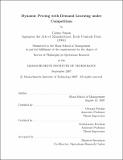| dc.contributor.advisor | Georgia Perakis and Soulaymanè Kachani. | en_US |
| dc.contributor.author | Simon, Carine (Carine Anne Marie) | en_US |
| dc.contributor.other | Massachusetts Institute of Technology. Operations Research Center. | en_US |
| dc.date.accessioned | 2008-09-02T17:57:13Z | |
| dc.date.available | 2008-09-02T17:57:13Z | |
| dc.date.copyright | 2007 | en_US |
| dc.date.issued | 2007 | en_US |
| dc.identifier.uri | http://hdl.handle.net/1721.1/42064 | |
| dc.description | Thesis (Ph. D.)--Massachusetts Institute of Technology, Sloan School of Management, Operations Research Center, 2007. | en_US |
| dc.description | This electronic version was submitted by the student author. The certified thesis is available in the Institute Archives and Special Collections. | en_US |
| dc.description | Includes bibliographical references (p. 199-204). | en_US |
| dc.description.abstract | In this thesis, we focus on oligopolistic markets for a single perishable product, where firms compete by setting prices (Bertrand competition) or by allocating quantities (Cournot competition) dynamically over a finite selling horizon. The price-demand relationship is modeled as a parametric function, whose parameters are unknown, but learned through a data driven approach. The market can be either in disequilibrium or in equilibrium. In disequilibrium, we consider simultaneously two forms of learning for the firm: (i) learning of its optimal pricing (resp. allocation) strategy, given its belief regarding its competitors' strategy; (ii) learning the parameters in the price-demand relationship. In equilibrium, each firm seeks to learn the parameters in the price-demand relationship for itself and its competitors, given that prices (resp. quantities) are in equilibrium. In this thesis, we first study the dynamic pricing (resp. allocation) problem when the parameters in the price-demand relationship are known. We then address the dynamic pricing (resp. allocation) problem with learning of the parameters in the price-demand relationship. We show that the problem can be formulated as a bilevel program in disequilibrium and as a Mathematical Program with Equilibrium Constraints (MPECs) in equilibrium. Using results from variational inequalities, bilevel programming and MPECs, we prove that learning the optimal strategies as well as the parameters, is achieved. Furthermore, we design a solution method for efficiently solving the problem. We prove convergence of this method analytically and discuss various insights through a computational study. | en_US |
| dc.description.abstract | (cont.) Finally, we consider closed-loop strategies in a duopoly market when demand is stochastic. Unlike open-loop policies (such policies are computed once and for all at the beginning of the time horizon), closed loop policies are computed at each time period, so that the firm can take advantage of having observed the past random disturbances in the market. In a closed-loop setting, subgame perfect equilibrium is the relevant notion of equilibrium. We investigate the existence and uniqueness of a subgame perfect equilibrium strategy, as well as approximations of the problem in order to be able to compute such policies more efficiently. | en_US |
| dc.description.statementofresponsibility | by Carine Simon. | en_US |
| dc.format.extent | 204 p. | en_US |
| dc.language.iso | eng | en_US |
| dc.publisher | Massachusetts Institute of Technology | en_US |
| dc.rights | M.I.T. theses are protected by
copyright. They may be viewed from this source for any purpose, but
reproduction or distribution in any format is prohibited without written
permission. See provided URL for inquiries about permission. | en_US |
| dc.rights.uri | http://dspace.mit.edu/handle/1721.1/7582 | en_US |
| dc.subject | Operations Research Center. | en_US |
| dc.title | Dynamic pricing with demand learning under competition | en_US |
| dc.type | Thesis | en_US |
| dc.description.degree | Ph.D. | en_US |
| dc.contributor.department | Massachusetts Institute of Technology. Operations Research Center | |
| dc.contributor.department | Sloan School of Management | |
| dc.identifier.oclc | 231846029 | en_US |
